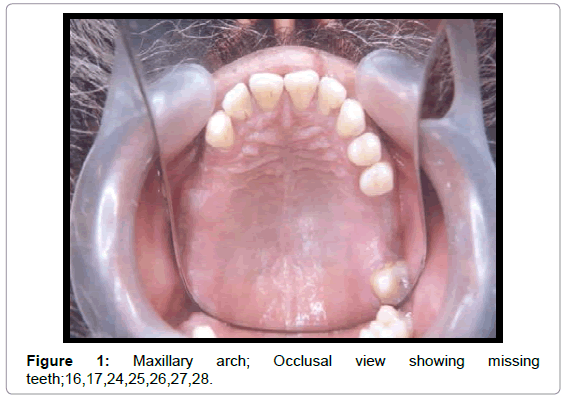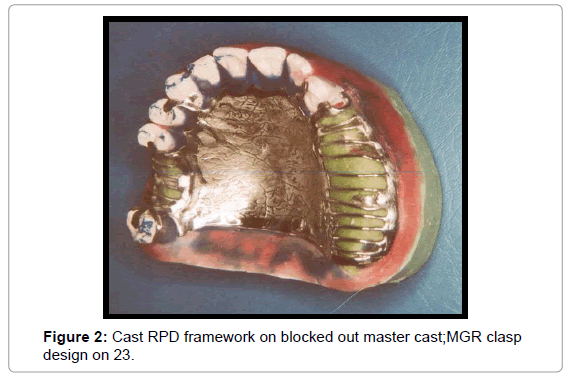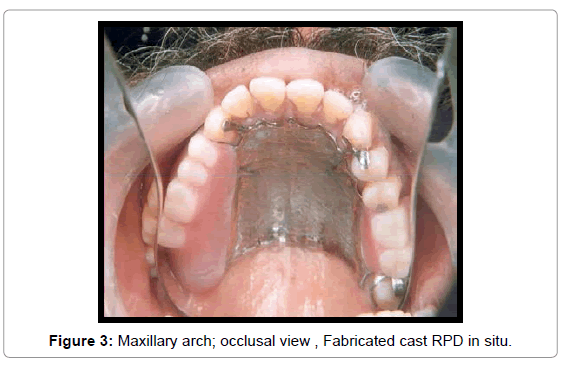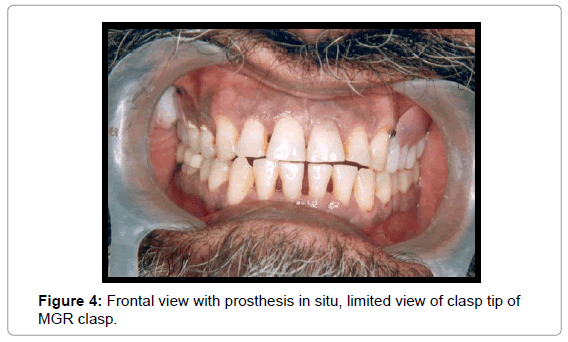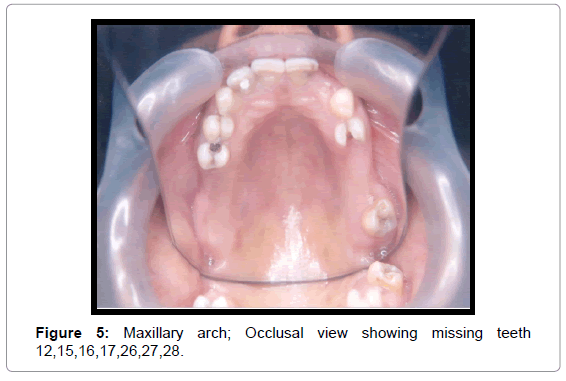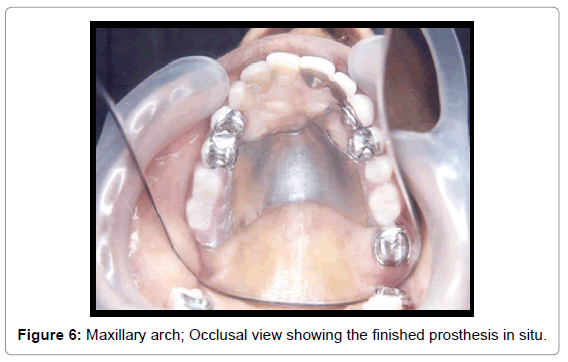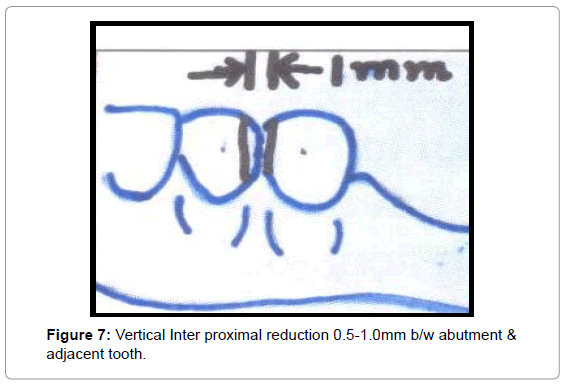Case Report Open Access
Esthetic Cast Direct Retainers for Distal Extension Removable Partial Dentures
Maninder Hundal*
Department of Prosthodontics, Military Dental Centre, Ahmednagar, Maharashtra India
- *Corresponding Author:
- Maninder Hundal
Department of Prosthodontics
Military Dental Centre
Ahmednagar, Maharashtra, India
Tel: 91-9419483923
E-mail:maninderhundal10471@gmail.com
Received Date: March 14, 2014; Accepted Date: April 25, 2014; Published Date: May 05, 2014
Citation: Hundal M (2014) Esthetic Cast Direct Retainers for Distal Extension Removable Partial Dentures. J Oral Hyg Health 2:134. doi:10.4172/2332-0702.1000134
Copyright: © 2014 Hundal M, et al. This is an open-access article distributed under the terms of the Creative Commons Attribution License, which permits unrestricted use, distribution, and reproduction in any medium, provided the original author and source are credited.
Visit for more related articles at Journal of Oral Hygiene & Health
Abstract
Extra coronal cast direct retainers are an essential component of cast removable partial denture prosthesis. The conventional cast circumferential clasp or the bar clasp appear unaesthetic due to visible metal display when used in the smile zone. This article describes two hidden clasp designs as an alternative to the conventional extra coronal cast direct retainer assembly for the distal extension partially edentulous situation. The same is highlighted via two case reports.
Keywords
Cast removable partial denture; Esthetics; Hidden clasp design
Introduction
Evidence based dentistry suggests that the need for restoration of partially edentulous condition is on the rise [1]. Not every patient presenting with a distal extension partially edentulous situation is a candidate for implant therapy either due to medical or financial limitations [2]. Therefore the cast removable partial denture (RPD) is here to stay until the stem cell research reaches a stage wherein the entire missing human tooth can be bioengineered in vivo.
The conventional extra coronal cast circumferential or bar clasp can be quite an eye sore when used in the anterior part of the mouth. Although precision attachments or resilient retainer systems may be used, conventional extra coronal clasp assembly still remains the most commonly used direct retainer because they are less technique sensitive and more versatile in their application. With this background we present two ‘Hidden clasp designs’ [3] for the distal extension situation which satisfies the criterion of esthetics and function in an apt manner. We do so through the following case reports incorporating these designs.
Case Report 1
This case incorporates the Mesial Groove Reciprocation (MGR) clasp [4] which is an esthetic extracoronal retainer for the maxillary canine in a distal extension RPD when the canines are used as abutments.
A 36 year old NCO reported at the Out Patient Department (OPD) of Command Military Dental Centre (CMDC) Northern Command (NC) with the chief complaint of difficulty in chewing due to missing upper posterior teeth
Intraoral examination revealed:
1. Partially edentulous condition (Missing teeth: 16,17,24,25,26,27,28&47)
2. Caries involving tooth: 21
3. Gingival health normal (Figure 1)
Treatment included:
1. Thorough oral prophylaxis
2. Composite restoration in tooth: 21
3. Three unit Ceramometal FPD replacing tooth: 47
4. Maxillary cast RPD replacing the missing teeth incorporating the MGR clasp for tooth: 23 (Figures 2-4)
Case Report 2
This case incorporates the Equipoise RPD System design which is an esthetic retentive concept for the distal extension situation especially when the premolars are used as abutments. A 35 year old wife of a serving army officer reported at the OPD of CMDC (NC) with chief complaints of compromised esthetics, pain in some of her cariously involved upper and lower teeth and difficulty in chewing food.
Intraoral clinical examination revealed:
i. Partially edentulous condition (Missing teeth; 12, 15, 16, 17, 26, 27, 28, 36, 37, 46, 47 & 48)
ii. Dental caries in teeth; 11, 15, 24, 28, 38 & 45
iii. Gingival health normal (Figure 5)
Treatment included:
i. Thorough oral prophylaxis
ii. Composite restoration for the cariously involved teeth
iii. Three unit Ceramometal FPD replacing tooth: 12
iv. Ceramometal crowns for teeth; 14, 24, 25, 33, 34, 44 & 45
v. Full metal crowns for teeth;18 & 38
vi. Maxillary Cast RPD involving Equipoise clasp system for teeth; 24,25,44,45. Internally braced clasp for teeth; 14 & 34. Cast circumferential clasp for teeth;18 & 38 (Figure 6)
Conclusion
Restoring facial esthetics in a cast RPD while keeping the biomechanical principles in mind can be a challenge. Various hidden clasp designs are available which modify visibility of the direct retainer in the esthetic zone [5]. Some of these are the MGR clasp, saddle lock system, twin flex clasp [6], internally braced clasp [7] and the Equipoise RPD system.
In the MGR clasp design [8] retention is attained with a 19 gauge wrought I bar clasp arm the end of which engages a prepared ‘retentive dimple” on the distolabial surface of the canine (abutment) which is hidden from the frontal view. The surfaces of the abutment are modified as under mentioned:
a) The labial surface is prepared so that its height of contour is at the same occlusogingival level as that of the lingual surface. The distal height of contour is also modified to retain at least 2-3 mm of infrabulge.
b) Instead of a distal guide plane, a 1 mm retentive dimple is prepared in the centre of the distal half of the labial surface, gingival to the height of contour.
c) A vertical mesial groove guide plane 1-2 mm in length is prepared in the mesiolingual surface within the mesiomarginal ridge enamel nearly parallel to the planned path of placement as possible. This mesial reciprocation groove is extended over the mesiomarginal ridge to terminate in a spoon shaped mesial rest seat. This rest seat will usually require a small supplemental amalgam as dentin may be exposed when preparing sufficient depth for lateral force resistance.
d) Reciprocation for the retentive clasp arm is provided by both the distal proximal plate and the mesiolingual rod like minor connector which engages the above explained vertical mesial groove guide plane. Both these reciprocating features are parallel to the path of placement. Simultaneous, continuous tooth contact is maintained as the prosthesis is either seated or removed and as the clasp arm flexes over the height of contour in much the same manner as the reciprocation provided by a lingual plate.
The Functional dynamics of MGR clasp design are explained below:
a) Resistance to occlusogingival movement of the MGR clasp is provided by the occlusal rest and denture base.
b) Mesogingival relief in the retentive dimple and infrabulge contour gingival to the tooth contact of the disto proximal plate permits a non binding rotation of the denture base about the fulcrum of the mesial rest.
c) The Indirect retention is provided by a mesial rest anterior to the fulcrum line on the canine or premolar of the contra lateral side.
d) Functional rotation in maxillary distal extension prosthesis can occur but it is usually minimal because of the additional support provided by the broad palatal major connector.
e) Resistance to gingivoocclusal displacement of the MGR clasp is provided by the retentive clasp arm and the mesiolingual minor connector as well as the distal proximal plate.
drawbacks of the MGR clasp design are:
a) It can only be used on abutments with adequate crown height.
b) This design does not permit the retentive terminal to completely disengage from the tooth during functional movements of the prosthesis hence the major connector and base should provide as much vertical support as possible.
c) Extensive palatal coverage is usually necessary which may be uncomfortable for the patient.
The Equipoise RPD system [9] was proposed by J.J. Goodman and is an esthetic retentive concept for distal extension situation and works very well on premolar abutment. In this design the occlusal rest is placed away from the edentulous span. The equipoise clasp is a retentive lingual back action clasp which encircles more than 180° of the greatest circumference of tooth, extends from the mesial and circles around the lingual and distal surfaces of the tooth to engage the distobuccal undercut. It is kind to the abutment tooth as it disengages when the partial denture is in function. Vertical interproximal reduction of 0.5mm-1mm from tooth adjacent to the abutment is done so that rigid metal of the RPD framework can extend into this area which provides reciprocation (Figure 7). An optional bucco-lingual retentive groove at mid and gingival third junction on distal surface of abutment tooth may be provided.
Goodman advocated that in addition to its esthetic superiority the unique class II lever design protects, preserves and strengthens abutment tooth while directing all forces down the long axis of the concerned tooth.
The drawbacks of this design are:
a) The concept does not work well on anterior natural teeth without visibility of the framework through the contact area.
b) The interproximal tooth reduction makes it carries susceptible.
c) The mesial proximal plate may introduce torque.
d) There can be potential loss of proximal space with a non complaint patient
e) During processing of the cast RPD, excess acrylic may surround the clasp thus preventing its flexure into the retentive undercut. Also the clasp may not seat completely in the mouth or may place unfavourable forces on the abutment tooth. “Freeing up” the clasp after processing is difficult and time consuming. To counter this, a stalite spacer is placed around the clasp during processing which can be easily removed during finishing and polishing procedure.
Conclusion
To conclude the MGR clasp and Equipoise clasp designs are good alternatives to the conventional extracoronal cast circumferential or bar clasp direct retainer in a distal extension partially edentulous situation thereby providing esthetically functional care which is the demand of today’s patient clientele.
References
- Alan B Carr, Glen P McGiveney, David T Brown (2000) Removable partial prosthodontics. Mosby Inc. Publishers. St Louis, Missouri, 6-7.
- Stewart, Rudd, Kubekar (2003) Clinical removable partial prosthodontics. IshiyakuEuroAmerican, Inc. Publishers. St Louis, Tokyo. 6-8.
- De Rossi A, Albuquerque RF Jr, Bezzon OL (2001) Esthetic options for the fabrication of removable partial dentures: a clinical report. J Prosthet Dent 86: 465-467.
- McCartney JW (1981) The MGR clasp: an esthetic extracoronal retainer for maxillary canines. J Prosthet Dent 46: 490-493.
- Reagan SE, Rold TM (1996) Practical, esthetic options for retention of removable partial dentures: a case report. Quintessence Int 27: 333-340.
- Belles DM (1997) The Twin-Flex clasp: an esthetic alternative. J Prosthet Dent 77: 450-452.
- Ben-Ur Z, Aviv I, Gorfil C (1989) The internally braced removable partial denture clasp--a solution to a common esthetic problem. Quintessence Int 20: 195-197.
- Hansen CA, Iverson GW (1986) An esthetic removable partial denture retainer for the maxillary canine. J Prosthet Dent 56: 199-203.
- Aras MA, Chitre V (2005) Direct retainers in the smile zone. Journal of Prosthet Dent 5: 4-9.
Relevant Topics
- Advanced Bleeding Gums
- Advanced Receeding Gums
- Bleeding Gums
- Children’s Oral Health
- Coronal Fracture
- Dental Anestheia and Sedation
- Dental Plaque
- Dental Radiology
- Dentistry and Diabetes
- Fluoride Treatments
- Gum Cancer
- Gum Infection
- Occlusal Splint
- Oral and Maxillofacial Pathology
- Oral Hygiene
- Oral Hygiene Blogs
- Oral Hygiene Case Reports
- Oral Hygiene Practice
- Oral Leukoplakia
- Oral Microbiome
- Oral Rehydration
- Oral Surgery Special Issue
- Orthodontistry
- Periodontal Disease Management
- Periodontistry
- Root Canal Treatment
- Tele-Dentistry
Recommended Journals
Article Tools
Article Usage
- Total views: 19677
- [From(publication date):
July-2014 - Apr 24, 2025] - Breakdown by view type
- HTML page views : 14327
- PDF downloads : 5350

